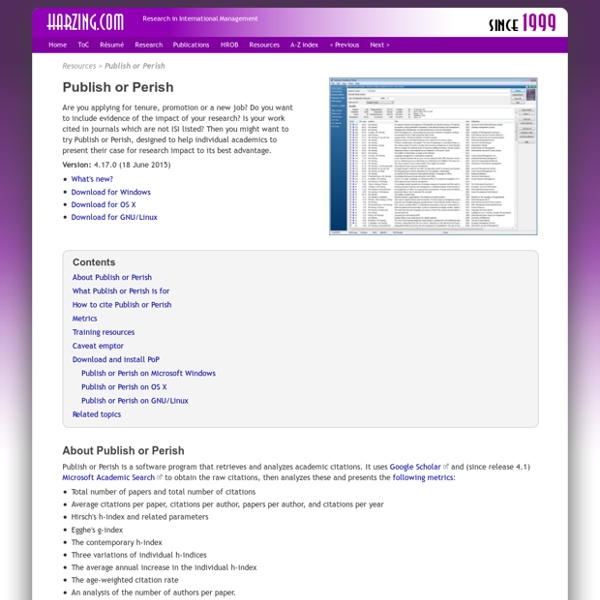Action Science Explorer (Formerly iOpener Workbench)
Latest News January 2012. Our paper on Action Science Explorer was accepted by JASIST, the Journal of the American Society for Information Science and Technology. See the Publications section below for more details. December 2011. July 2010. Description The goal of the iOpener project is to generate readily-consumable surveys of different scientific domains and topics, targeted to different audiences and levels. Action Science Explorer is partially an integration of two powerful existing tools the SocialAction network analysis tool and the JabRef reference manager. JabRef supplies all the features one would expect from a reference manager, including searching using simple regular expressions, automatic and manual grouping of papers, DOI and URL links, PDF full text with annotations, abstracts, user generated reviews and text annotations, and many ways of exporting. These tools are linked together to form multiple coordinated views of the data. Data & Summarization Video Demonstration
RERO DOC
Google Scholar
Research Impact
NodeXL: Network Overview, Discovery and Exploration for Excel
Scholar Citations Help
Google Scholar Citations provide a simple way for authors to keep track of citations to their articles. You can check who is citing your publications, graph citations over time, and compute several citation metrics. You can also make your profile public, so that it may appear in Google Scholar results when people search for your name, e.g., richard feynman. Best of all, it's quick to set up and simple to maintain - even if you have written hundreds of articles, and even if your name is shared by several different scholars. Get started with Google Scholar Citations Setting up your profile You can sign up for a Google Scholar Citations profile. First, sign to your Google account, or create one if you don't yet have one. Select the "Add" option from the Actions menu. To add one article at a time, click "Search articles" and then "Add article" next to the article you wish to add. If your search doesn't find the right article, click "Add article manually". Select both versions of the article.
Scholar Metrics Help
Google Scholar Metrics provide an easy way for authors to quickly gauge the visibility and influence of recent articles in scholarly publications. Scholar Metrics summarize recent citations to many publications, to help authors as they consider where to publish their new research. To get started, you can browse the top 100 publications in several languages, ordered by their five-year h-index and h-median metrics. To see which articles in a publication were cited the most and who cited them, click on its h-index number to view the articles as well as the citations underlying the metrics. You can also explore publications in research areas of your interest. To explore specific research areas, select one of the broad areas, click on the "Subcategories" link and then select one of the options. Browsing by research area is, as yet, available only for English publications. Scholar Metrics are currently based on our index as it was in July 2013. Available Metrics Coverage of Publications
Web of Science [v5.13] - Please Sign In to Access Web of Science
WEB OF Science Your ideal single research destination to explore the citation universe across subjects and around the world. Web of Science provides you access to the most reliable, integrated, multidisciplinary research connected through linked content citation metrics from multiple sources within a single interface. Web of Science connects the entire search and discover process through: Premier Multidisciplinary Content Emerging Trends Subject Specific Content Regional Content Research Data Analysis Tools Learn more about Web of Science Take advantage of many great features when you register. Access Web of Science from outside your institution using roaming capabilities Use your Web of Science account to create a ResearcherID profile that showcases your publication history Set up citation alerts whereby you are notified by email when an article on your Alerts list has been cited Learn more about the benefits of registering for an account
Automatic Graph Layout
Microsoft Automatic Graph Layout (MSAGL), formerly known as GLEE, is a .NET tool for laying out and visualizing directed graphs. You can use MSAGL to represent complex directed graphs, such as those found in business management, manufacturing, and network analysis, as well as phylogenetic trees, which are used in bioinformatics research. MSAGL is now available for purchase at the Microsoft online store. Microsoft Automatic Graph Layout, formerly known as Graph Layout Execution Engine (GLEE), is a .NET tool for laying out and visualizing directed graphs. GLEE is still available as a free download. Automatic Graph Layout is now available for purchase at Microsoft Store. Differences between GLEE and Automatic Graph Layout: You can use Automatic Graph Layout to represent complex directed graphs, such as those found in business management, manufacturing, and network analysis, as well as phylogenetic trees, which are used in bioinformatics research.
ORCID



